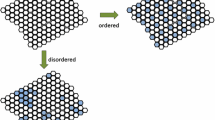Abstract
Levels of reality reflect one kind of complexity, which can be modeled using a specification hierarchy. Levels emerged during the Big Bang, as physical degrees of freedom became increasingly fixed as the expanding universe developed, and new degrees of freedom associated with higher levels opened up locally, requiring new descriptive semantics. History became embodied in higher level entities, which are increasingly individuated, aggregate patterns of lower level entities. Development is an epigenetic trajectory from vaguer to more definite and individuated embodiment, punctuated by the emergence of new integrative levels. It is constrained by being subsumed by lower levels (e.g., physical dynamics) and may be guided by structural attractors as well as by internally stored information (e.g., genes) in the higher levels. I conjecture, on a thermodynamic basis, that the number of levels that become manifest in an expanding universe depends upon its rate of expansion.

Similar content being viewed by others
References
Agazzi E, Faye J (eds) (2001) The problem of the unity of science. World Scientific, Singapore
Conway Morris S (2003) Life’s solution: inevitable humans in a lonely universe. Cambridge University Press, Cambridge
Esposito JL (1977) Schelling’s idealism and philosophy of nature. Bucknell University Press, Lewisburg
Esposito JL (1980) Evolutionary metaphysics: the development of Peirce’s theory of categories. Ohio University Press, Athens
Feibleman JK (1959) Theory of integrative levels. Br J Philos Sci 17:59–66
Goodwin BC (1991) Development. Hodder & Stoughton; Open University, London
Hausman CR (1993) Charles S. Peirce’s evolutionary philosophy. Cambridge University Press, Cambridge
Keefe R (2000) Theories of vagueness. Cambridge University Press, Cambridge
Lineweaver CH (2005) Cosmological and biological reproducibility: limits of the maximum entropy production principle. In: Kleidon A, Lorenz R (eds) Non-equilibrium thermodynamics and the production of entropy: life, earth and beyond. Springer, Berlin, Heidelberg, New York
Lorenz RD (2002) Planets, life and the production of entropy. Int J Astrobiol 1:3–13. doi:10.1017/S1473550402001027
Lugt HJ (1983) Vortex flow in nature and technology. Wiley, New York
Needham J (1943) Integrative levels: a revaluation of the idea of progress. In: Needham J (ed) Time: the refreshing river. George Allen & Unwin, London
Neurath O, Carnap R, Morris C (eds) (1955, 1970) Foundations of the unity of science. toward an international encyclopedia of unified science, vol I and II. University of Chicago Press, Chicago
Newman SA, Müller GB (2000) Epigenetic mechanisms of character origination. J Exp Zool B Mol Dev Evol 288:304–317. doi:10.1002/1097-010X(20001215)288:4<304::AID-JEZ3>3.0.CO;2-G
Odum HT, Pinkerton RC (1955) Time’s speed regulator, the optimum efficiency for maximum output in physical and biological systems. Am Sci 43:331–343
Peirce CS (1905) Issues of pragmatism. Monist 15:481–499
Polanyi M (1968) Life’s irreducible structure. Science 160:1308–1312. doi:10.1126/science.160.3834.1308
Poli R (2001) The basic problem of the theory of levels of reality. Axiomathes 12:261–283. doi:10.1023/A:1015845217681
Prigogine I (1980) From being to becoming: time and complexity in the physical sciences. Freeman, San Francisco
Reid RGB (2007) Biological emergences: evolution by natural experiment. MIT Press, Cambridge
Rosen R (1985) Organisms as causal systems which are not mechanisms: an essay into the nature of complexity. In: Rosen R (ed) Theoretical biology and complexity: three essays on the natural philosophy of complex systems. Academic Press, New York
Salthe SN (1972) Evolutionary biology. Holt Rinehart & Winston, New York
Salthe SN (1985) Evolving hierarchical systems: their structure and representation. Columbia University Press, New York
Salthe SN (1988) Notes toward a formal history of the levels concept. In: Greenberg G, Tobach E (eds) Evolution of social behavior and integrative levels. L. Erlbaum Associates, Hillsdale
Salthe SN (1993) Development and evolution: complexity and change in: biology. MIT Press, Cambridge
Salthe SN (2002) Summary of the principles of hierarchy theory. Gen Syst Bull 31:13–17
Salthe SN (2004) The origin of new levels in dynamical hierarchies. Entropy 6:327–343
Salthe SN (2006) Two frameworks for complexity generation in biological systems. In: Gershenson C, Lenaerts T (eds) Evolution of complexity, ALifeX proceedings. Indiana University Press, Bloomington
Salthe SN (2007) The natural philosophy of work. Entropy 9:83–99
Salthe SN (2008) Natural philosophy: developmental systems in the thermodynamic perspective. In: Çakmak C (ed) Festschrift In Honor of Saban Teoman Durali. Dergah Yaylinlari, Istanbul
Salthe SN (2009) Development (and evolution) of the universe. Presented in absentia, Evo Devo Universe, 2008 Paris meeting
Sharma V, Annila A (2007) Natural process—natural selection. Biophys Chem 127:123–128. doi:10.1016/j.bpc.2007.01.005
Turner MS (2007) Quarks and the cosmos. Science 315:59–61. doi:10.1126/science.1136276
West-Eberhard M (2003) Developmental plasticity and evolution. Oxford University Press, Oxford
Willey A (1911) Convergence in evolution. E.P. Dutton, New York
Author information
Authors and Affiliations
Corresponding author
Additional information
Salthe has worked in evolutionary biology, systems science (hierarchy theory), and semiotics. Current interests include thermodynamics and internalism.
Rights and permissions
About this article
Cite this article
Salthe, S.N. A Hierarchical Framework for Levels of Reality: Understanding Through Representation. Axiomathes 19, 87–99 (2009). https://doi.org/10.1007/s10516-008-9056-x
Received:
Accepted:
Published:
Issue Date:
DOI: https://doi.org/10.1007/s10516-008-9056-x




